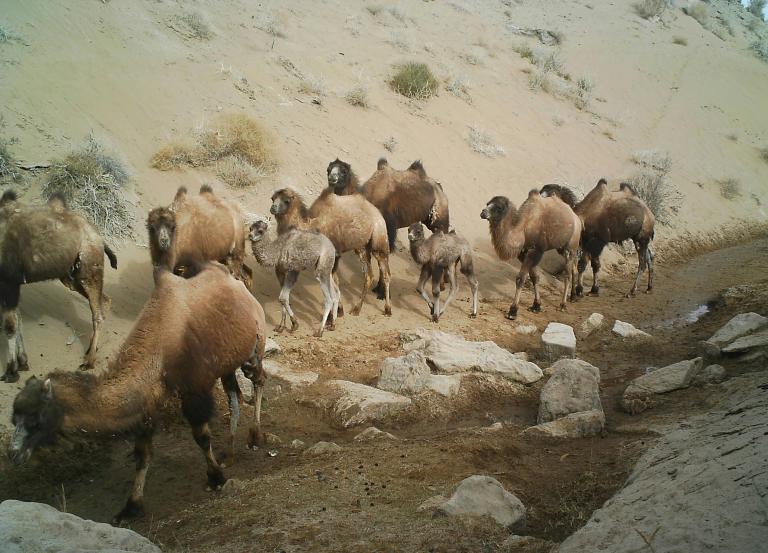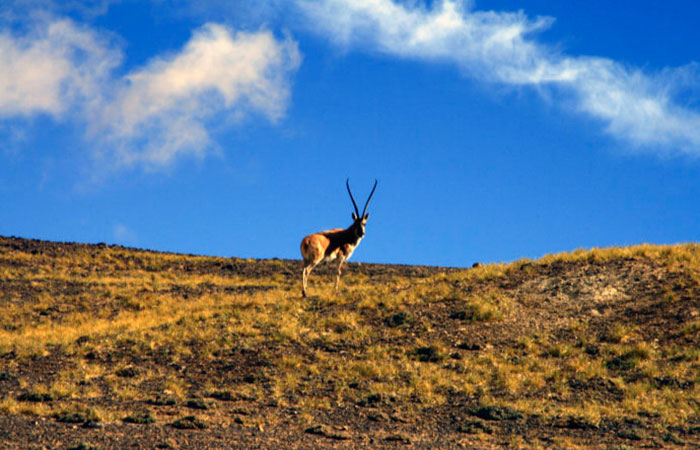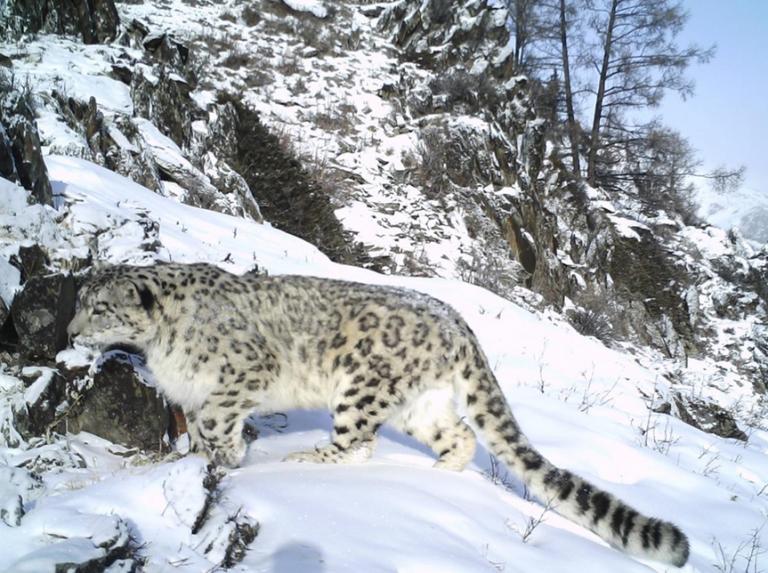Wild animals
9 min readXinjiang is rich in wild animal resources, and there are 144 species of wild mammals,423 species of birds,59 kinds of amphibious reptiles,48 species of native fish, and 70 species of introducing fish. Among them,27 species are under first-class national protection,88 species are under secondary national protection, and 44 species are under the key protection of Xinjiang. Most wild animals in Xinjiang have important ecological value and high economic value. The protection, development and rational exploitation of these precious resources are of great significance to the ecological civilization construction and economic development in Xinjiang.

Snow leopard
Snow leopard is the mountain master among the beasts in Xinjiang with the nicknames of Grass leopard and Panthera uncial, distributing in Qinghai-Tibet Plateau, Xinjiang, Gansu and Inner Mongolia. It has a body length of 110 to 130 cm,a tail length of 80 to 90cm, weight of 38 to 75kg,a small and round head, and a tail as long as its body. Its hair is long and dense: the back hair is about 3cm long, the chest hair is up to 6.5cm long, and the tail hair is long and fluffy. It is smaller than other leopards, with grayish yellow or gray hair, and blurred or irregular large black annular plaques scattered on the back and rib. It inhabits at the area of an altitude of 2,000 to 6,000 m, and is often found on mountain bare rocks; it is fierce, alert, and dexterous, mainly feeding on blue sheep, argali, etc, and it also hunts other small animals such as hare, marmot and pheasant. The oestrum of snow leopard is in late winter or early spring, with a gestation period of 90 to 103 days, and it gives birth to 2 to 3 cubs in each delivery, every June to July. It is sexually mature at the age of two, and the life span is usually 10 years, and the longest can be up to 15.8 years. Snow leopard is the expert of mountain-climber, and also good at climbing trees. It can prey on a variety of alpine animals; it always catches the blue sheep with the way of a surprise attack by biting its throat. In order to hunt, the snow leopard often travels very far following a certain route in a region, and returns back along the same route several days later. The number of snow leopards is very small, and the species is under the endangered status, so they are the wildlife under first class protection, and also the precious ornamental and fur animals, with precious medicinal value. Snow leopards also have a high economic value, so they are theobjects of hunting and killing. Especially because of the fixed routes, the poachers caneasily succeed hunting them. Meanwhile, the decline in the number of blue sheep is alsoa disaster for snow leopards. It is difficult for them to adapt to the areas of lower altitudes, so it is rare for zoos to breed snow leopards around the world.
Przhevalski’s Horse
Przhevalski’s Horse is the only surviving wild horses around the world currently, and after 60 million years of evolution, it is called the “living fossil”regarded as more precious than the panda. It originates in Junggar Basin in northern Xinjiang and the Mongolia ariddesert steppe zone, so it is also known as the Junggar or Mongolian wild horse. Its number of captivity in the world is no more than 1,500. It is first found and collected specimens in Junggar Basin in 1878 by the Russian explorer Nicholas Przhevalsky, so it was named as “Przhevalski’s Horse”.
Przhevalski’s Horse is a large ungulates mammal, with a body length of 210cm,a shoulder height of about 110 cm,a tail length of 90 cm, and a weight of 350 kg. It is strong with a long and big head and thick neck, its ears are shorter than that of the donkey and it has wide and round hoofs. It looks like the Equus caballus, but there is no long hair on th forehead, and the neck bristle is short and upright. Its back is flat, with a clear dark back line, extending along the spine from the shoulder to the tail. Its limbs are stubby, with gray hair inside of the legs and two to five distinct black stripes. Its lower leg is black, commonly known as the “stepping green”leg. Its tail is thick and long, and it is almost perpendicular to the ground. There is short hair on the tail base of the horse, and the shape of the tail is bundle-like which is different from the Equus caballus. The number of chromosomes of Przhevalski’s Horse is 66, which is a pair more than that of the Equus caballus.
They live on the upland meadow at the mild slope, open desert and Gobi, and also on deserts and Gobiwith better water and grass conditions.
Przhevalski’s Horses are alert and good at running, active both at day and night, but more in the night. They always live a wandering life in a group of 5 to 20 with a strong male horse as the leader, and often go to springs and streams to drink along the fixed route in the morning and evening. After feed, they may clean the skin for each other, usually standing opposite to each other, and heading to the sideways of the companion, gently licking and biting the withers, shoulders, backs and rumps. They both lick and bite the same part, and when one changes for another part, the other immediately changes accordingly, cooperating with very tacit understanding. They sometimes take self-care, including rolling, self-brushing and dispersing mosquitoes and flies, etc, especially when in the sand. There are three kinds of postures: standing, lying on the belly, and lying on the side for resting and sleeping. They have a high vigilance and become stringent at the slightest movement.
They feed on Achnatherum splendens, Haloxylon, reed, and rose willow in the desert, and they can dig in snow for withered grass in winter. They need to drink a large amount of water. They can make various kinds of sounds:a single sharp roar during the beginning of a fight;a loud and sonorous call when lost its flock; slight gutturals when feel satisfied; and sharp and fine sounds when in antipathy. What they like most is to make nose sounds, expressing very complex emotions, mostly to intimidate the others, and the sounds may also be caused by something in the nasal cavity, the interference of mosquitoes and flies, odor stimulation or cold illness.
They can be in heat all year round, but mainly in spring and summer. The estrous cycle of the female is 28 to 22 days, lasting for 5 to 7 days. The performances are mental excitement, appetite decreases, fidgets, irritability, and sniffing each other. The gestationperiod is about 307 to 348 days, and they give birth in the next May to June. The cubs are light earthy yellow when they are just born and start to suck two hours later; they get sexually mature at about 3 years old, and the life span is about 30 years.
From 1899 to 1903,a total of about 50 wild horses had been transported to Europe, becoming the first batch of artificial feeding Przhevalski’s Horse. Currently, the feeding number has reached 1,500 around the world. However, there is still a recession problem caused by inbreeding, for the whole captive population is from only about 10 Przhevalski’s Horses.
In the 1960s, Mongolia first announced the extinction of Przhevalski’s Horse, and in the 1970s, Przhevalski’s Horse also almost disappeared in their hometown of Xinjiang.
On August 14,1986, Chinese Ministry of Forestry and the People’s Government of Xin jiang Uygur Autonomous Region founded a dedicated agency responsible for the work of “The Return of Przhevalski’s Horse”, and also built the largest breeding center in Asiawhich is of 6km-in Jimsar County at the southern edge of Junggar Basin. With the return of 18Przhevalski’s Horse from the United Kingdom, the United States, and Germany, their original hometown has put an end to the history of “No-Przhevalski’s Horse”.
Xin jiang is the first place to initiate the plan of “The Return of Przhevalski’s Horse”.16 years after the introduction from abroad, on August 28,2001, Xinjiang conducted the first experimental release, during which 27 Przhevalski’s Horse are released to Kalamely natural preservation zone with the leading horse of “Junggar No.11”. Today, the stable population has formed in the breeding center with 75 Przhevalski’s Horse growing freely in the wild.

Mongolian Wild Ass
Mongolian Wild Ass is a wild animal under first-class national protection and the world endangered animal. The total quantity of Mongolian Wild Ass is about 3,000, only existing in Junggar Basin, and it is typical plateau cold desert animal.
Mongolian Wild Ass is a large ungulates animal. It looks like a mule, with a body length of up to 260 cm,a shoulder height of about 120 cm,a tail length of about 80cm and a weight of 250kg. The snout is long and thin, ears are long and sharp, and the tail is also long and sharp with long brown hair. Limbs are strong, and hoofs are slightly smaller than those of the horse but slightly larger than those of the donkey. It has short bristles on the nape. It is light yellow brown on the dorsal neck, shoulder, and back. There is a brown line on the central back extending to the end of the base of the tail. It is yellowish-white under the neck, chest, both sides of the body and on the belly, and there is no clear dividing line with the color of dorsal part.
Mongolian Wild Ass inhabits at the Plateau Sub Frigid Zone of an altitude of 3,000 to 5 ,000 m, living a wandering life. It has a strong endurance and can resist cold and heat, and also hunger and thirst. It can live without drinking for several days, and eat snow to quench the thirst in winter. It feeds on grasses of gramineae, cyperaceae, and liliaceae. The sound is short and hoarse as donkeys. It mates from August to September; male donkeys need to compete to win the right to mate, and the gestation period is about 11 months, giving birth to just one cub each time.
The Mongolian Wild Ass have the habit of being active in cluster, the female, male and the young wandering together throughout the year, with each group of 5 to 8 or 20 to 30. In summer, the group would be large in the places with good water and grass conditions and with less human interference. The number of one group is always 100 to 200 for the Mongolian Wild Ass living at the lakeside of Yixiakepati Lake in Altunshan Nature Reserve, while in Harteng Basin at the northern margin of the Qaidam Basin, the number is usually 3to 5, and it is also common to act individually. Their auditory, olfactory and visual senses are very sensitive, and able to detect the situations a few hundred meters away. If they find any approach or attack from predators, they first look around quietly, and then run away after a short glance. When they feel safe, they would stop to watch around again, and then go on running.
They have another habit of a short-distance migration with the season. Their activities are usually very regular: drinking at the water source in the morning, feeding and resting on the meadow during the day, and going back to the deep mountains to stay over night. They would wander tens of kilometers a day in a line if they are not disturbed. They often walk along a fixed route near the pasture and water source, leaving the unique”Donkey Trail”on the grassland. The trail is 20cm wide and stretches to everywhere.
When in drought, the clever Mongolian Wild Ass would “dig wells”at the places of high water table at the bay, digging the big water pits of half a meter deep with their hoofs, which are known as the “donkey well”.
There is a sentry donkey in each group with high vigilance, and is always devoted to its duty. When you are 500 to 600 meters close to it, it will start to run away slowly, stopping and then running again, always keeping a distance of 500 to 600 meters from you. It is tempting you to go to the opposite direction of the group to ensure the safety of the entire group. In case of a danger, the leading one will lead the group of 20 to more than 200 to run away in a line, and the scene is very spectacular.
When the Kalamely Natural Preservation Zone was established in 1981, there were only450 Mongolian Wild Ass, and now the number has reached to about 4,000 after years of protection.
Xin jiang is rich in various species of wild animals, and they are too numerous to becounted clear. There are different wild animals in Northern and Southern Xin jiang. In Northern Xin jiang, the beasts mainly include snow leopard, sable, brown bear, beaver, otter, marmot, squirrel, snow hare, capra ibex, and lynx, etc.; birds mainly include swan, thunderbird, snow cock, and woodpecker; and the reptiles mainly include flower snake, prairie viper, and grass snake. While in Southern Xin jiang, the beasts mainly include camel, Tibetan antelope, wild yak, wild horse, Tarim rabbit, pika, woolly hare, jungle cat and felis lybica silvestris; and the reptiles mainly include sand python and lizard and so on.









